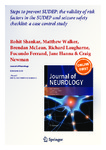Steps to prevent SUDEP: the validity of risk factors in the SUDEP and seizure safety checklist: a case control study
| dc.contributor.author | Shankar, R | |
| dc.contributor.author | Walker, M | |
| dc.contributor.author | McLean, B | |
| dc.contributor.author | Laugharne, R | |
| dc.contributor.author | Ferrand, F | |
| dc.contributor.author | Hanna, J | |
| dc.contributor.author | Newman, C | |
| dc.date.accessioned | 2018-06-12T13:05:39Z | |
| dc.date.issued | 2016-09 | |
| dc.identifier.issn | 0340-5354 | |
| dc.identifier.issn | 1432-1459 | |
| dc.identifier.uri | http://hdl.handle.net/10026.1/11649 | |
| dc.description.abstract |
Our objectives were to compare people with epilepsy (PWE) who died of sudden unexpected death in epilepsy (SUDEP) with live controls using the risk factor items of the SUDEP and Seizure Safety Checklist. All 48 SUDEPs of 93 epilepsy deaths which occurred in Cornwall UK 2004-2012 were compared to 220 live controls using the SUDEP and Seizure Safety Checklist, an evidenced based tool used to communicate person centered risk of SUDEP to PWE. The odds ratio for having a specific factor in those who died was compared to controls and ranked according to P value using a sequential Bonferroni correction for multiple comparisons. Of the 17 modifiable and non-modifiable risk factors analyzed 9 were statistically significant of which 7 are potentially modifiable. Well known modifiable factors such as nocturnal monitoring, compliance and sleeping position featured prominently in the risk association. This is the first case control study exploring the risk factors for SUDEP since 2009. The findings are compared to the current considered risk factors as identified in a major recent review. The study further validates certain SUDEP risk factors. It highlights that the majority of risk factors strongly associated with SUDEP are potentially modifiable. There is an emerging profile to rank the risk factors. It furthers the evidence to use structured risk assessment and communication tools such as the SUDEP and Seizure Safety Checklist in daily clinical practice. It highlights key areas for a person centered discussion to empower PWE to mitigate risk. | |
| dc.format.extent | 1840-1846 | |
| dc.format.medium | Print-Electronic | |
| dc.language | en | |
| dc.language.iso | en | |
| dc.publisher | Springer Science and Business Media LLC | |
| dc.subject | SUDEP | |
| dc.subject | Case-control study | |
| dc.subject | Risk factors | |
| dc.subject | Epilepsy deaths | |
| dc.title | Steps to prevent SUDEP: the validity of risk factors in the SUDEP and seizure safety checklist: a case control study | |
| dc.type | journal-article | |
| dc.type | Article | |
| plymouth.author-url | https://www.ncbi.nlm.nih.gov/pubmed/27334909 | |
| plymouth.issue | 9 | |
| plymouth.volume | 263 | |
| plymouth.publication-status | Published | |
| plymouth.journal | Journal of Neurology | |
| dc.identifier.doi | 10.1007/s00415-016-8203-3 | |
| plymouth.organisational-group | /Plymouth | |
| plymouth.organisational-group | /Plymouth/Faculty of Health | |
| plymouth.organisational-group | /Plymouth/REF 2021 Researchers by UoA | |
| plymouth.organisational-group | /Plymouth/REF 2021 Researchers by UoA/UoA03 Allied Health Professions, Dentistry, Nursing and Pharmacy | |
| plymouth.organisational-group | /Plymouth/Research Groups | |
| plymouth.organisational-group | /Plymouth/Research Groups/Institute of Health and Community | |
| plymouth.organisational-group | /Plymouth/Research Groups/Institute of Translational and Stratified Medicine (ITSMED) | |
| plymouth.organisational-group | /Plymouth/Research Groups/Institute of Translational and Stratified Medicine (ITSMED)/CCT&PS | |
| plymouth.organisational-group | /Plymouth/Users by role | |
| dc.publisher.place | Germany | |
| dcterms.dateAccepted | 2016-06-10 | |
| dc.rights.embargodate | 2017-09-01 | |
| dc.identifier.eissn | 1432-1459 | |
| dc.rights.embargoperiod | 12 months | |
| rioxxterms.versionofrecord | 10.1007/s00415-016-8203-3 | |
| rioxxterms.licenseref.uri | http://www.rioxx.net/licenses/under-embargo-all-rights-reserved | |
| rioxxterms.licenseref.startdate | 2016-09 | |
| rioxxterms.type | Journal Article/Review |


